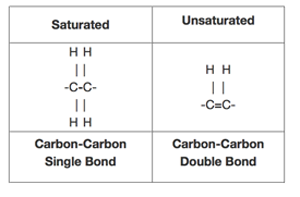Oleic Acid

The lipid shown here is Oleic Acid in a ball-and-stick configuration.
Monounsaturated
- Oleic Acid - CH3(CH2)7CH=CH(CH2)7COOH - (C:D = 18:1)

The structure of saturated and unsaturated chemical bonds looks like the diagram below.

Oleic Acid is a monounsaturated fatty acid. The name derives from the Latin word oleum, which means oil. Oleic aicd is the most common fatty acid in nature.
Where is Oleic Acid Found?
Fatty acids (or their salts) do not often occur as such in biological systems. Instead fatty acids like oleic acid occur as their esters, commonly triglycerides, which are the greasy materials in many natural oils. Triglycerides of oleic acid comprise the majority of olive oil. Triacylglycerols are normally composed of a mixture of three fatty acids. Most prevalent in olive oil is the oleic-oleic-oleic (OOO). The higher the oleic acid monounsaturated fat content translates to increased durability and shelf-life. High amounts of free oleic acid renders olive oil inedible. The highest quality olive oil (Extra-Virgin olive oil) must feature a free acidity lower than 0.8%. Virgin olive oil is characterized by acidity between 0.8% and 2%,
Oleic acid also makes up 59–75% of pecan oil, 61% of canola oil, 36–67% of peanut oil, 60% of macadamia oil, 20–80% of sunflower oil, 15–20% of grape seed oil, sea buckthorn oil, and sesame oil, and 14% of poppyseed oil. High oleic variants of plant sources like sunflower (~80%) and canola oil (70%) has also been developed. It is abundantly present in many animal fats, constituting 37 to 56% of chicken and turkey fat and 44 to 47% of lard. Oleic acid is the most abundant fatty acid in human adipose tissue, and second in abundance in human tissues overall only to palmitic acid.
Food sources of oleic acid (MFA 18:1), listed in descending order by percentages of their contribution to intake, based on data from the National Health and Nutrition Examination Survey 2005-2006. Source National Cancer Institute| Rank | Food item | Contribution to intake (%) | Cumulative contribution (%) |
|---|---|---|---|
| 1 | Grain-based desserts | 8.9 | 8.9 |
| 2 | Chicken and chicken mixed dishes | 7.6 | 16.6 |
| 3 | Sausage, franks, bacon, and ribs | 5.9 | 22.5 |
| 4 | Nuts/seeds and nut/seed mixed dishes | 5.5 | 27.9 |
| 5 | Pizza | 5.4 | 33.3 |
| 6 | Fried white potatoes | 4.9 | 38.2 |
| 7 | Mexican mixed dishes | 4.6 | 42.8 |
| 8 | Burgers | 4.1 | 46.9 |
| 9 | Beef and beef mixed dishes | 3.9 | 50.8 |
| 10 | Eggs and egg mixed dishes | 3.5 | 54.3 |
| 11 | Regular cheese | 3.3 | 57.5 |
| 12 | Potato/corn/other chips | 3.2 | 60.7 |
| 13 | Pasta and pasta dishes | 3.1 | 63.8 |
| 14 | Salad dressing | 2.6 | 66.4 |
| 15 | Dairy desserts | 2.3 | 68.7 |
| 16 | Yeast breads | 2.2 | 70.9 |
Specific foods contributing at least 1% of octadecenoic acid in descending order: cold cuts, quickbreads, crackers, candy, reduced fat milk, pork and pork mixed dishes, whole milk, other fish and fish mixed dishes, margarine, soups, butter.
Health Benefits of Oleic Acid
From: An overview of the modulatory effects of oleic acid in health and disease.
"...Evidences in the last years have showed the effects of oleic acid (OA) in human health and disease. Olive oil, rich in oleic acid, is supposed to present modulatory effects in a wide physiological functions, while some studies also suggest a beneficial effect on cancer, autoimmune and inflammatory diseases, besides its ability to facilitate wound healing. Although the OA role in immune responses are still controversial, the administration of olive oil containing diets may improve the immune response associated to a more successful elimination of pathogens such as bacteria and fungi, by interfering in many components of this system such as macrophages, lymphocytes and neutrophils. Then, novel putative therapies for inflammatory and infectious diseases could be developed based on the characteristics presented by unsaturated fatty acids like OA. Finally, the purpose of this work was to review some of the modulatory effects of OA on inflammatory diseases and health, aiming at high lightening its potential role on the future establishment of novel therapeutic approaches for infections, inflammatory, immune, cardiovascular diseases or skin repair based on this fatty acid mainly found in the Mediterranean diet...."
Fats in Cooking and Health
- What are the differrent types of fatty acids?
- What are Trans Fats?
- What is the difference between LDL and HDL?
- What are the different types of omega 3 fatty acid?
- What are omega-6 fatty acids?
- The importance of the ratio of omega-6/omega-3 essential fatty acids
- What is the difference between saturated and unsaturated fats?
- What causes oils to go rancid?
- What are essential fatty acids?
- Duck Fat as an alternative to butter
- How to render duck fat
- Did butter get a bad rap?
Types of Fatty Acids
Saturated